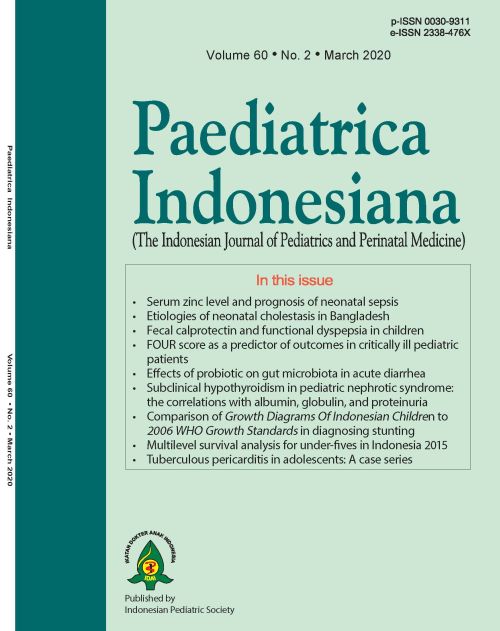Multilevel survival analysis for under-fives in Indonesia 2015
DOI:
https://doi.org/10.14238/pi60.2.2020.103-9Keywords:
survival; under-five; individual factor; contextual factorAbstract
Background Marking the end of the Millennium Development Goals (MDGs) era, governments continue their plans via the Sustainable Development Goals (SDGs). One of the MDGs that has continued is the reduction in under-five mortality. Even though the trend of under-five mortality in Indonesia is decreasing, more efforts are needed to reduce the under-five mortality rate.
Objective To determine the individual and contextual factors of the under-five survival rate and to assess for possible characteristics that may lead to variance among regencies in Indonesia.
Methods Data from 2015 Intercensal Population Survey (Survei Penduduk Antar Sensus/SUPAS 2015) in Indonesia were analyzed using multilevel survival analysis. The Intercensal Population Survey covers all regions in Indonesia up to the regency level. Data were collected by direct interviews of selected household members, with regards to demographic and household characteristics, including births and deaths of under-fives. Our sample population was limited to all under-fives who were born and died during the 2010-2015 period. The number of subjects analyzed was 219,413 after exclusion of children with incomplete data.
Results Individual factors associated with under-five survival rate were maternal education, maternal age at first birth, work status, sex, previous birth interval, type of birth, place of residence, and sanitation level. The contextual factor (health care facility ratio per 1000 under-fives per regency) was not associated with under-five survival rate. The 5.27% variance can be explained by the differing characteristics among regencies.
Conclusion The individual factors affecting the survival of under-fives are maternal education, maternal age at first birth, maternal work status, sex, previous birth interval, type of birth, place of residence, and sanitation level.
References
2. United Nations. Report of the inter-agency and expert group on sustainable development goal indicators. (E/CN.3/2017/2), Annex III. New York: United Nations; 2016. p.17.
3. Hox JJ, Moerbeek M, van de Schoot R. Multilevel analysis: techniques and applications. East Sussex : Routledge; 2010. p. 1.
4. Lee ET, Wang J. Statistical methods for survival data analysis. New Jersey: John Wiley & Sons; 2003. p. 230-3.
5. Badan Pusat Statistik. Profil penduduk Indonesia hasil SUPAS 2015. Jakarta: BPS; 2016. p.?
6. Cleland JC, Ginneken KVAN, Jo SI. Maternal education and child survival in developing countries?: The search for pathways of influence. Soc Sci Med. 1988;27:1357-68.
7. Kayode GA, Adekanmbi VT, Uthman OA. Risk factors and a predictive model for under-five mortality in Nigeria: Evidence from Nigeria demographic and health survey. BMC Pregnancy Childbirth. 2012;12:12:10. doi:10.1186/1471-2393-12-10.
8. Kishor S, Parasuraman S. Mother's employment and infant and child mortality in India. National Family Health Survey Subject Reports Number 8. Mumbai: The International Institute for Population Sciences; 1998. p. 1-40.
9. Ettarh RR, Kimani J. Determinants of under-five mortality in rural and urban Kenya. Rural Remote Health. 2012:12:1812. PMID: 22417123.
10. Ronsmans C. Birth spacing and child survival in rural Senegal. Int J Epidemiol. 1996;25:989-997. doi:10.1093/ije/25.5.989.
11. Gebretsadik S, Gabreyohannes E. Determinants of Under-Five Mortality in High Mortality Regions of Ethiopia: An Analysis of the 2011 Ethiopia Demographic and Health Survey Data. 2016:3-4. doi:10.1155/2016/1602761.
12. Sastry N. What explains rural-urban differentials in child mortality in Brazil? 1997;44:989-1002. DOI: 10.1016/s0277-9536(96)00224-9.
13. Fink G, Günther I, Hill K. The effect of water and sanitation on child health: Evidence from the demographic and health surveys 1986-2007. Int J Epidemiol. 2011;40:1196-1204. doi:10.1093/ije/dyr102.
Downloads
Published
How to Cite
Issue
Section
License
Authors who publish with this journal agree to the following terms:
Authors retain copyright and grant the journal right of first publication with the work simultaneously licensed under a Creative Commons Attribution License that allows others to share the work with an acknowledgement of the work's authorship and initial publication in this journal.
Authors are able to enter into separate, additional contractual arrangements for the non-exclusive distribution of the journal's published version of the work (e.g., post it to an institutional repository or publish it in a book), with an acknowledgement of its initial publication in this journal.
Accepted 2020-04-22
Published 2020-04-24


















